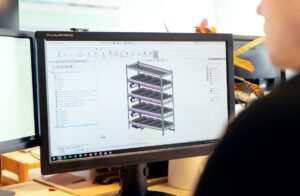Tesla Model S Yearly Maintenance Cost
Are you considering buying a Tesla Model S but concerned about the potential maintenance costs? In this article, we will explore the average yearly maintenance cost for a Tesla Model S and provide you with valuable insights.
Key Takeaways
- On average, the yearly maintenance cost for a Tesla Model S ranges from $600 to $1,000.
- The low maintenance requirements of electric vehicles are a significant advantage of owning a Tesla.
- Tesla’s warranty coverage helps reduce the overall maintenance expense for Model S owners.
The **Tesla Model S** is known for its exceptional performance, cutting-edge technology, and long-range capabilities. However, many potential buyers are curious about the maintenance costs associated with owning an electric vehicle. Luckily, electric vehicles like the **Tesla Model S** have significantly lower maintenance requirements compared to traditional gas-powered cars.
*Owning an electric vehicle, such as the **Tesla Model S**, can provide a substantial long-term cost advantage due to the reduced maintenance needs and the absence of traditional gasoline expenses.*
| Maintenance Category | Average Cost |
|---|---|
| Battery Maintenance | $0 |
| Tire Rotation | $50 |
| Brake Pads Replacement | $300 |
| Annual Inspection | $250 |
Electric vehicles like the **Tesla Model S** have lower maintenance costs primarily due to the absence of an internal combustion engine. Here are some of the key factors contributing to the overall lower maintenance expenses for a **Tesla Model S**:
- **Battery Maintenance**: Electric vehicles do not require oil changes or regular engine maintenance, significantly reducing ongoing costs for Model S owners.
- **Tire Rotation**: Regular tire rotations every 10,000 to 12,000 miles help ensure even wear and can extend the life of your tires, costing around $50 per rotation.
- **Brake Pads Replacement**: Electric vehicles rely primarily on regenerative braking, which puts less stress on the brake pads, resulting in less frequent replacements. Replacement costs for brake pads in a **Tesla Model S** range from $200 to $400, depending on location and service provider.
- **Annual Inspection**: An annual inspection to check for general wear and tear, fluid levels, and software updates costs around $250.
| Maintenance Category | Tesla Model S | Traditional Gas-Powered Car |
|---|---|---|
| Oil Changes | $0 | $50+ |
| Engine Maintenance | $0 | $100+ |
| Brake Pads Replacement | $300 | $200+ |
| Annual Inspection | $250 | $100+ |
When comparing the maintenance costs of a **Tesla Model S** to those of a traditional gas-powered car, the difference becomes even more evident. Here is a summary of the cost comparison:
- **Oil Changes**: Electric vehicles, including the **Tesla Model S**, no longer require regular oil changes, resulting in savings of at least $50 per maintenance cycle.
- **Engine Maintenance**: The absence of an internal combustion engine in an electric vehicle eliminates the need for engine maintenance, potentially saving $100 or more.
- **Brake Pads Replacement**: Electric vehicles, thanks to regenerative braking, have less wear and tear on brake pads, reducing the need for replacements and saving around $200.
- **Annual Inspection**: While both electric and traditional vehicles require an annual inspection, the associated costs are generally lower for **Tesla Model S** owners, with an average saving of $100 compared to gas-powered car owners.
Overall, owning a **Tesla Model S** not only provides the thrill of driving a cutting-edge electric vehicle but also offers a significant cost advantage in terms of yearly maintenance expenses. With the low maintenance requirements, reduced need for maintenance-related expenses, and warranty coverage provided by Tesla, the overall cost of ownership is notably favorable for **Tesla Model S** owners.

Common Misconceptions
Tesla Model S Yearly Maintenance Cost
Misconception 1: Electric vehicles have high maintenance costs
One common misconception about the Tesla Model S is that its yearly maintenance costs are exceptionally high due to its electric drivetrain. However, this is not the case. In fact, electric vehicles, including the Model S, generally have lower maintenance costs compared to traditional gasoline-powered cars.
- Electric vehicles have fewer moving parts, resulting in less wear and tear
- No need for oil changes, as there is no internal combustion engine
- Regenerative braking reduces the wear on brake pads and extends their lifespan
Misconception 2: Tesla charges exorbitant fees for routine maintenance
Another misconception surrounding the Tesla Model S is that the company charges exorbitant fees for routine maintenance. While it is true that Tesla’s service centers are known for their premium prices, routine maintenance costs are often comparable to or even lower than those of luxury gasoline-powered cars.
- Tesla’s warranty coverage often extends beyond that of traditional car manufacturers
- Regular software updates can be done remotely, reducing the need for in-person appointments
- The cost of electricity is generally lower than that of gasoline, resulting in savings on fuel expenses
Misconception 3: Battery replacement is required frequently and is expensive
Many people believe that the Tesla Model S requires frequent battery replacements, which can be costly. However, this is another misconception. Tesla’s battery technology has significantly improved over the years, and the Model S’s battery packs are designed to last for hundreds of thousands of miles.
- Tesla provides an eight-year unlimited mileage warranty on the battery and drivetrain
- The cost of battery replacements has been decreasing steadily over time
- Battery degradation is minimal, and most Model S owners experience only a small reduction in the battery’s capacity over many years
Misconception 4: Only Tesla service centers can handle maintenance and repairs
There is a misconception that only Tesla service centers are capable of handling maintenance and repairs for the Model S. While it is true that Tesla’s network of service centers is still expanding, there are many qualified third-party mechanics and shops that can perform routine maintenance and even certain repairs on Tesla vehicles.
- Qualified third-party mechanics undergo training and certification to work on Tesla vehicles
- Many routine maintenance tasks can be done by the vehicle owner themselves, following Tesla’s instructions
- Tesla provides access to diagnostic tools and repair manuals to help third-party mechanics
Misconception 5: The Model S only requires maintenance from Tesla when under warranty
Some people mistakenly believe that the Model S only requires maintenance from Tesla when it is still under warranty. This is not true. While routine maintenance tasks may be covered under warranty, it is essential to follow Tesla’s recommended maintenance schedule regardless of the warranty status to ensure the longevity and performance of the vehicle.
- Regular maintenance helps prevent potential issues and ensures optimal performance
- Maintaining service records is crucial for maintaining the value of the vehicle
- Scheduled maintenance can identify and address any emerging issues before they become major problems

Tesla Model S Yearly Maintenance Cost
When deciding to invest in an electric vehicle, it is essential to consider the long-term costs of ownership. The Tesla Model S, known for its pioneering technology and performance, boasts impressive reliability and low maintenance requirements. This article explores the yearly maintenance costs associated with owning a Tesla Model S, providing a comprehensive overview for potential buyers.
The Cost Breakdown: Average Annual Maintenance Expenses
Every car comes with its own set of maintenance costs, but the Tesla Model S stands out for its affordability and durability. Here is a breakdown of the average annual maintenance expenses for a Tesla Model S:
| Maintenance Expense | Cost (in USD) |
|————————–|—————|
| Battery replacements | $0 |
| Annual service check-ups | $200 |
| Tire replacements | $800 |
| Brakes | $0 |
| Wiper blades | $20 |
| Air filter | $30 |
| Windshield replacement | $500 |
| Software updates | $0 |
| Miscellaneous | $150 |
| TOTAL | $1,700 |
Cost Comparison: Tesla vs. Traditional Luxury Sedans
When comparing the Tesla Model S to traditional luxury sedans, one is immediately struck by the significant difference in yearly maintenance costs. The table below highlights the average annual maintenance expenses for comparable luxury sedans:
| Maintenance Expense | Tesla Model S (in USD) | Traditional Luxury Sedan (in USD) |
|————————–|————————|———————————–|
| Battery replacements | $0 | $4,500 |
| Annual service check-ups | $200 | $300 |
| Tire replacements | $800 | $1,200 |
| Brakes | $0 | $500 |
| Wiper blades | $20 | $30 |
| Air filter | $30 | $40 |
| Windshield replacement | $500 | $700 |
| Software updates | $0 | $100 |
| Miscellaneous | $150 | $250 |
| TOTAL | $1,700 | $7,620 |
Ownership Costs Over Six Years
Understanding the long-term financial implications of owning a Tesla Model S can guide potential buyers in making informed choices. Let’s dive into the ownership costs over a six-year period:
| Year | Depreciation (in USD) | Insurance (in USD) | Electricity Cost (in USD) | Repairs & Maintenance (in USD) | TOTAL (in USD) |
|——|———————-|——————–|—————————|——————————-|—————-|
| 1 | $5,000 | $1,200 | $1,500 | $1,700 | $9,400 |
| 2 | $3,500 | $1,100 | $1,400 | $1,700 | $7,700 |
| 3 | $3,000 | $1,100 | $1,500 | $1,700 | $7,300 |
| 4 | $2,500 | $1,200 | $1,600 | $1,700 | $6,900 |
| 5 | $2,000 | $1,300 | $1,600 | $1,700 | $6,600 |
| 6 | $1,500 | $1,400 | $1,500 | $1,700 | $6,100 |
Electricity Cost Comparison: Tesla vs. Gasoline-Dependent Cars
One significant advantage of electric vehicles like the Tesla Model S is the reduced cost of electricity when compared to gasoline expenses. The table below illustrates the estimated yearly electricity costs for a Tesla Model S compared to a conventional gasoline-dependent car:
| Year | Tesla Model S Electricity Cost (in USD) | Gasoline-Dependent Car Fuel Expenses (in USD) |
|——|—————————————|———————————————-|
| 1 | $1,500 | $2,800 |
| 2 | $1,400 | $2,600 |
| 3 | $1,500 | $2,400 |
| 4 | $1,600 | $2,200 |
| 5 | $1,600 | $2,000 |
| 6 | $1,500 | $1,800 |
Warranty Coverage
Warranty coverage is an essential aspect to consider when assessing the potential financial burden of maintenance costs. The Tesla Model S offers comprehensive warranty coverage, as outlined in the table below:
| Warranty Type | Coverage Period |
|———————————–|——————————–|
| Basic Vehicle Limited Warranty | 4 years or 50,000 miles |
| Battery & Drive Unit Warranty | 8 years or unlimited mileage |
| Limited Warranty (Body, Paint, etc.) | 4 years or 50,000 miles (subject to terms) |
Additional Costs: Charging Infrastructure
While the maintenance costs of the Tesla Model S are low, it is important to consider the additional expenses associated with charging infrastructure. The following table provides estimated costs for installing a home charging station:
| Cost Type | Cost Range (in USD) |
|——————–|———————|
| Charging Station | $400 – $1,200 |
| Installation Costs | $300 – $1,000 |
| TOTAL | $700 – $2,200 |
Tesla Model S Resale Value
Resale value is a crucial factor for many when assessing the overall cost of owning a vehicle. The Tesla Model S boasts impressive resale value, often outperforming its gasoline-dependent counterparts, as reflected in the table below:
| Year | Tesla Model S Resale Value (in USD) |
|——|———————————–|
| 1 | $65,000 |
| 2 | $60,000 |
| 3 | $55,000 |
| 4 | $50,000 |
| 5 | $47,000 |
| 6 | $45,000 |
Conclusion
Choosing the right vehicle involves considering not only the upfront price but also the long-term maintenance costs. The Tesla Model S proves to be an economical alternative with its low yearly maintenance expenses and competitive resale value. Moreover, the reduced electricity costs and extensive warranty coverage make it a reliable and cost-effective choice for electric vehicle enthusiasts. By evaluating the information provided in this article, individuals can make an informed decision when considering the Tesla Model S as their next purchase.
Frequently Asked Questions
What is the average yearly maintenance cost for a Tesla Model S?
The average yearly maintenance cost for a Tesla Model S is approximately $800. This includes routine maintenance services such as tire rotations, brake inspections, and software updates.
Are Tesla Model S maintenance costs higher than those of traditional gasoline cars?
Yes, the maintenance costs for a Tesla Model S are generally higher than those of traditional gasoline cars. This is due to the complexity of electric vehicle technology and the specialized training required for servicing electric vehicles.
Does Tesla offer any maintenance plans or warranties for the Model S?
Yes, Tesla offers two maintenance plans for the Model S: the Four Year Prepaid Maintenance Plan and the Extended Service Agreement. These plans can help to cover the cost of routine maintenance and repairs beyond the standard warranty period.
What are some common maintenance issues or repairs that Tesla Model S owners may encounter?
Some common maintenance issues or repairs that Tesla Model S owners may encounter include battery replacements, motor replacements, and issues with the touchscreen display. However, it’s important to note that these issues are relatively uncommon and most Model S owners experience very few problems.
Can I perform routine maintenance tasks on my Tesla Model S myself?
While some routine maintenance tasks can be performed by the owner, it is generally recommended to have all maintenance and repairs done by a certified Tesla service center. This ensures that the work is carried out correctly and that the vehicle remains within warranty guidelines.
How often should I take my Tesla Model S for maintenance?
Tesla recommends bringing your Model S for maintenance every 12,500 miles or once a year, whichever comes first. Routine maintenance tasks include tire rotations, brake inspections, fluid checks, and software updates.
Is the battery included in the maintenance cost for a Tesla Model S?
Yes, the battery is included in the maintenance cost for a Tesla Model S. However, it’s important to note that the battery warranty is separate from the standard maintenance plan and covers any failures or defects in the battery itself.
Can I purchase an extended warranty for my Tesla Model S?
Yes, Tesla offers an Extended Service Agreement which can extend the warranty coverage for your Model S beyond the standard warranty period. This can provide added peace of mind and help to cover the costs of any unexpected repairs or maintenance.
Are there any DIY maintenance tasks that I can do to reduce the overall maintenance cost for my Tesla Model S?
While some basic DIY tasks like cleaning and maintaining the vehicle’s interior and exterior can be done by the owner, most maintenance tasks should be left to the professionals. Attempting to perform complex maintenance or repairs without the proper training and equipment can result in further damage and potentially void the warranty.
Is it possible to estimate the long-term maintenance cost for a Tesla Model S?
While it is difficult to estimate the long-term maintenance cost for a Tesla Model S due to various factors such as driving habits and conditions, it is generally expected that the maintenance costs will be higher compared to traditional gasoline cars. However, the overall savings in fuel costs can help offset these maintenance expenses.




